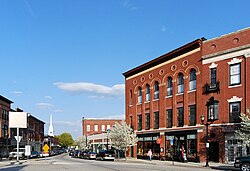Hudson, Massachusetts
| Hudson, Massachusetts | ||
|---|---|---|
| Town | ||

Wood Square
|
||
|
||
 Location in Middlesex County in Massachusetts |
||
| Coordinates: 42°23′30″N 71°34′00″W / 42.39167°N 71.56667°WCoordinates: 42°23′30″N 71°34′00″W / 42.39167°N 71.56667°W | ||
| Country | United States | |
| State | Massachusetts | |
| County | Middlesex | |
| Settled | 1699 | |
| Incorporated | 1866 | |
| Government | ||
| • Type | Open town meeting | |
| • Executive Assistant | Thomas Moses | |
| • Board of Selectmen | Joseph Durant Scott R. Duplisea Fred P. Lucy II James D. Quinn John Parent |
|
| Area | ||
| • Total | 11.8 sq mi (30.7 km2) | |
| • Land | 11.5 sq mi (29.8 km2) | |
| • Water | 0.3 sq mi (0.9 km2) | |
| Elevation | 263 ft (80 m) | |
| Population (2010) | ||
| • Total | 19,063 | |
| • Density | 1,702.6/sq mi (657.0/km2) | |
| Time zone | Eastern (UTC-5) | |
| • Summer (DST) | Eastern (UTC-4) | |
| ZIP code | 01749 | |
| Area code(s) | 351 / 978 | |
| FIPS code | 25-31540 | |
| GNIS feature ID | 0618226 | |
| Website | www |
|
Hudson is a town in Middlesex County, Massachusetts, United States.
Before its incorporation as a town in 1866, Hudson was a neighborhood and unincorporated village within the town of Marlborough, Massachusetts, and was known as Feltonville, and before that, known as Eastborough. From around 1850 until the last shoe factory burned down in 1968, Hudson was known as a "shoe town". At one point, the town had 17 shoe factories, many of them powered by the Assabet River, which runs through town. Because of the many factories in Hudson, immigrants were attracted to the town. Today, most people are of either Portuguese or Irish descent, with a smaller percentage of people being of French, Italian, English, or Scots-Irish descent. Hudson is served by the Hudson Public Schools district.
In 1650, the area that would become Hudson was part of the Indian Plantation for the Praying Indians. The Praying Indians were evicted from their plantation during King Philip's War, and most did not return even after the war ended.
The first European settlement of the Hudson area occurred in 1699 when settler John Barnes, who had been granted an acre of the Ockookangansett Indian plantation the year before, built a gristmill on the Assabet River on land that would one day be part of Hudson. By 1701, Barnes had also built a sawmill on the river and had built a bridge across it. Over the next century, Hudson grew slowly.
Hudson was part of the town of Marlborough and was known as Feltonville for part of that time, until its incorporation as a separate municipality in 1866. As early as June 1743 Hudson-area residents petitioned to break away from Marlborough and become a separate town, but this petition was denied by the Massachusetts General Court. Men from the present Hudson area fought with the Minutemen on April 19, 1775.
...
Wikipedia

